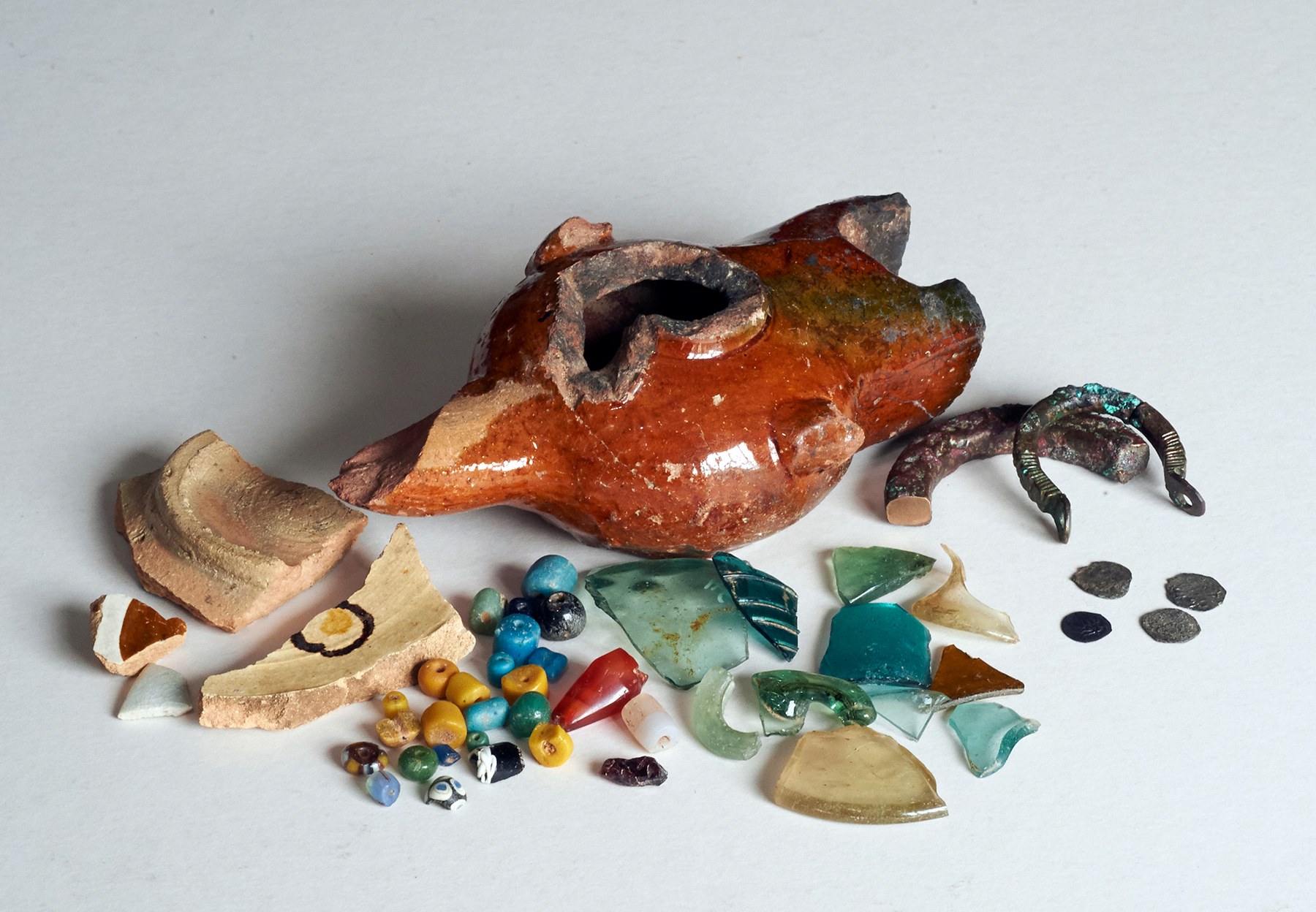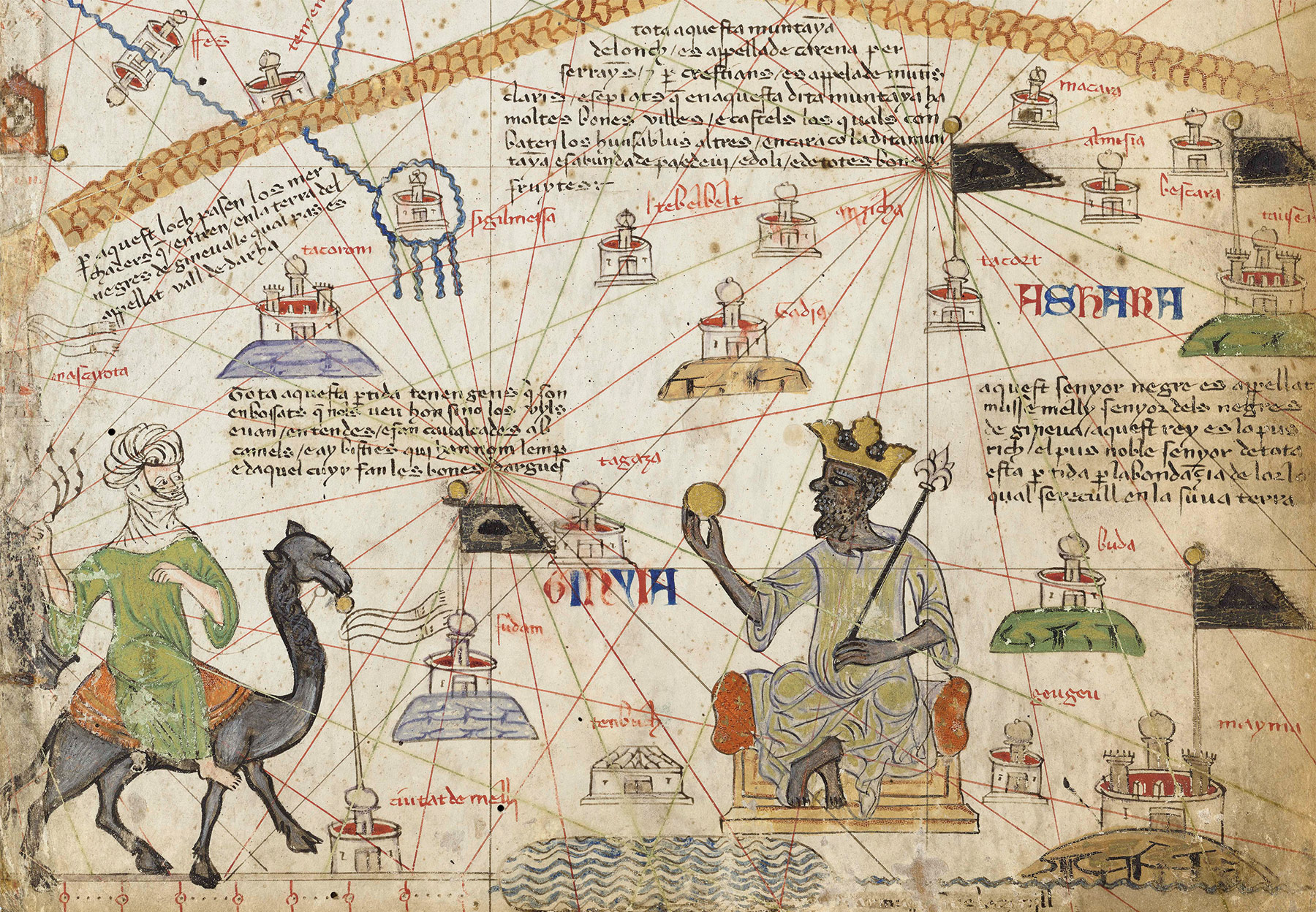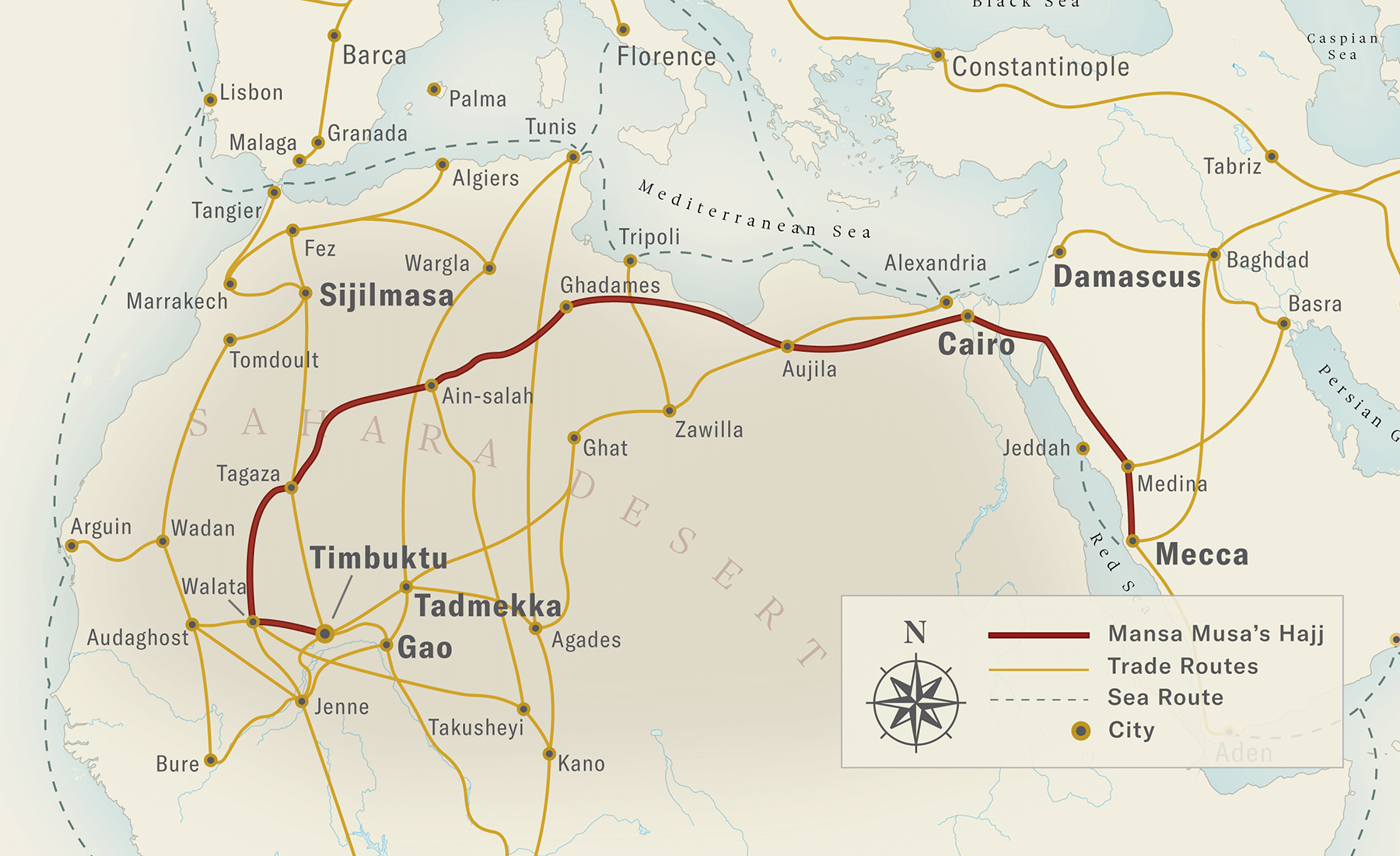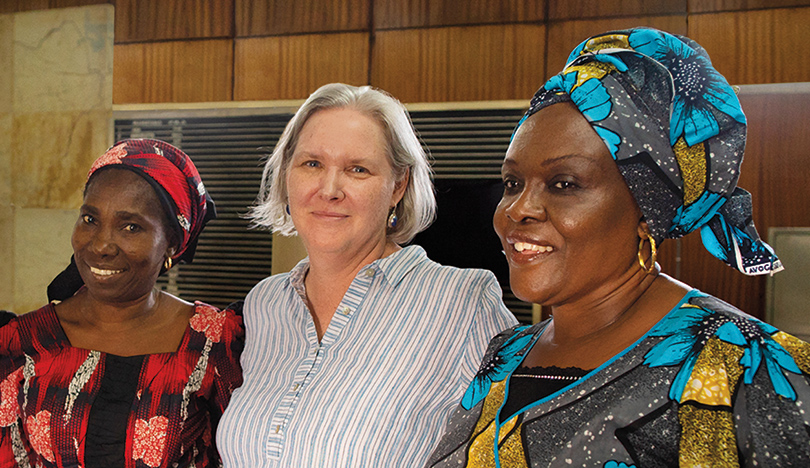The Kids Are All Right
Northwestern student groups inspire young audiences.
A Block Museum exhibition reveals the glory of Africa’s medieval past. By Stephanie Kulke
Crossing the Sahara Desert from the 8th to the 16th centuries, caravans with hundreds of camels carried gold, textiles, salt, jewelry and other precious goods across the desert. Through brutal heat, blinding sandstorms and the never-ending search for water, the caravans plodded thousands of miles across one of the most desolate regions in the world.
Despite its harsh terrain, the Sahara became a thriving crossroads of exchange for Africa, the Middle East, Europe and Asia in the medieval period. Fueling this exchange was West African gold, prized for its purity and used for minting currencies and adorning luxury and religious objects.
Major trade routes crossing the desert linked cities such as Timbuktu and Tadmekka on the southern fringes of the Sahara in present-day Mali and Sijilmasa on the desert’s northern side in present-day Morocco. Southward, the routes connected with the Niger River, a major waterway to West Africa’s forest region. Northward, they connected to the vast trade networks of the Mediterranean Sea.
The massive scale of medieval caravans diminished after the 16th century, but fragments of the goods they traded remain — and they tell a story of the remarkable role that the kingdoms of West and North Africa played in expanding trade and driving the movement of people, culture and beliefs throughout the medieval world. This was a world of globalization, where cultures and religions, including Islam and Christianity, met and circulated along Saharan trade routes.
To share this little-known story, the Block Museum of Art has put together a new exhibition: Caravans of Gold, Fragments in Time: Art, Culture and Exchange Across Medieval Saharan Africa — a first-of-its-kind show that celebrates West Africa’s historic and under-recognized global significance and showcases the objects and ideas that were exchanged at the crossroads of Africa, Europe, the Middle East and Asia.
“This exhibition takes us back to a period of time when West Africa played a hugely significant role in a global economy,” explains Kathleen Bickford Berzock, associate director of curatorial affairs at the Block Museum of Art and curator of the exhibition.
Caravans of Gold portrays the splendor and power of the medieval kingdoms and commercial centers of Africa, using centuries-old artifacts from sites around the Sahara Desert and artwork from West and North Africa, Europe and the Middle East that reveal the reach of Saharan networks. The show runs through July 21 at the Block Museum of Art.
The exhibition presents more than 250 artworks and fragments, representing more than six centuries and a vast geographic expanse.
For the show, the Block Museum secured rare and important loans from partner institutions in Mali, Morocco and Nigeria. Some of these objects are among the greatest treasures of the medieval period in West Africa, including several rare manuscripts from libraries in Timbuktu, which emphasize the role that the shared language and culture of Islam played in the expansion of African exchange networks.
The loans from Nigeria include iconic artworks — such as a rope-entwined vessel from Igbo Ukwu — and an extraordinary cast sculpture of a seated man in the style of Ife (an ancient city in Nigeria famous for its naturalistic sculptures) but found at the town of Tada on the Niger River. This figure is wrought of copper likely sourced in Europe. Seen next to sculptures from France, finely carved from African elephant tusks, together these artworks raise questions about the interdependency of materials that are ubiquitous to the medieval period.
However, many of the pieces in the exhibition are fragments — of lusterware, glass vessels, cast copperwork, terra cotta, porcelain and goldwork — remains of the Sahara’s medieval past that were unearthed at sites around the desert by archaeologists.
Caravans of Gold draws on recent archaeological discoveries, including rare fragments from major medieval African trading centers like Sijilmasa in Morocco, and Gao and Tadmekka in Mali. These “fragments in time” are shown alongside works of art that invite audiences to imagine them as they once were.
“The fragments are time travelers that are simultaneously of the past and in the present,” says Berzock. “They evoke what has been called ‘the archeological imagination’ — our ability to imagine the past through its remains,” adds Berzock, who was the curator of African art at the Art Institute of Chicago for 18 years before joining the Block in 2015.

Organizing an exhibition based on fragments is an unorthodox approach for an art museum. Most museum exhibitions focus on displaying complete artworks from a specific time and geographic place.
But few intact works of art from the region exist.
“In order to do an exhibition about the history of the medieval period in West Africa we have to be willing to display fragments,” says Berzock.
“Caravans of Gold is an act of retrieval, bringing together far-flung links to the past in order to correct and enlarge previous scholarly interpretations of medieval Africa,” says Lisa Corrin, the Block’s Ellen Philips Katz Director.
“Fragments, probably the hardest materials for a museum to make visual sense of, hold pride of place here,” Corrin explains. “We are inviting visitors to ‘read’ fragments, as archaeologists do, to imagine the past.”
Caravans of Gold requires that museum visitors help piece together the story of the Saharan trade routes themselves.
“What if you walked in here, and all you saw was a bead,” says Chris Abani, Northwestern Board of Trustees Professor of English, a Nigerian-born novelist, poet and essayist, winner of a 2009 Guggenheim Award and contributor to the exhibition’s companion publication (Caravans of Gold, Fragments in Time: Art, Culture and Exchange Across Medieval Saharan Africa, Kathleen Bickford Berzock, ed., Princeton University Press, 2019). “What story would you tell of the bead? You need to insert yourself not from the position of privilege but from the position of a kind of curiosity. And so that’s all we can ask — that you come here curious.”

The history of Africa as it’s told in museums and schools has traditionally focused on Africa during the colonial period and during the Atlantic slave trade.
Many stories are left untold, including that of Africa in the Middle Ages and six centuries of dazzling wealth and interconnection with the global exchange of materials, ideas and culture. In the early 14th century, much of that wealth belonged to Mansa Musa, king of the Mali Empire and perhaps the richest man who ever lived.
“The absence of West Africa in common perceptions about the Middle Ages is a serious shortcoming,” says Berzock. “Archaeologists’ site reports are full of enticing descriptions of material fragments uncovered in towns around the Sahara that were once thriving centers of trade.
“These materials are crucial to our study of the past, and for a curator they are also the starting point for making it tangible,” adds Berzock. “However, integrating them into an art museum exhibition is challenging because they fall outside of what is considered to be art.”
Berzock, who has grappled for nearly a decade with how best to represent the full scope of medieval West African history, believes there are several reasons for the historical omission, including the region’s nomadic traditions and desert environment. “Medieval period artifacts have been buried over centuries of time, and West Africa has not seen the same investment in archaeology as the Mediterranean region, where Greek architectural ruins are more valued in the West,” she says.
But the most significant reason is the West’s colonialization of Africa and the Atlantic slave trade. “The West constructed a history of Africa that allowed slavery and colonialization to persist,” Berzock says. “If you want to see people as lesser to support the ability to enslave them, it is convenient to forget the history of past greatness or label it as too distant to know. But it’s not OK for us to not know it.”

Medieval gold is abundantly on display in Caravans of Gold. Exhibition treasures include a page from the celebrated Blue Qu’ran, loaned by the Brooklyn Museum of Art, as well as clothing embroidered in gold-wrapped silk thread, golden jewelry, coins minted in North Africa and Europe and paintings and art objects embellished with gold.
Throughout the exhibition, a range of everyday and luxury objects piece together the distant past.
Caravans of Gold also explores the theme of the circulation of Islam as a religion as well as of Arabic as a spoken and written language in the medieval period.
“There are materials at archaeological sites in Mali that help us understand that Arabic was already making inroads across regions just below the Sahara Desert in the 10th century,” says Esmeralda Kale, the George and Mary LeCron Foster Curator of Northwestern’s Melville J. Herskovits Library of African Studies. “We believe that books were also circulating. The exhibition includes Arabic manuscripts from Northwestern’s Herskovits Library that document this history of the development of an intellectual tradition in West Africa that contributed to and continues to contribute to Islamic intellectualism up to the present day.”
When Berzock arrived at Northwestern, she was drawn by the museum’s integration within a research university and its collaborative approach with schools and departments across the campus, which further solidified the decision that Northwestern was the ideal place to further pursue her exhibition concept.
“Caravans of Gold is a project that arises organically from Northwestern’s multidisciplinary strengths and global reach,” Berzock says. In addition to the Herskovits Library, founded in 1954 and today the largest separate Africana collection in existence, the University is home to the nation’s first Program of African Studies. Northwestern is also home to the Center for Scientific Study in the Arts, a collaboration between the University and the Art Institute of Chicago, and the Roberta Buffett Institute for Global Affairs, which works to solve critical global problems through collaborative scholarship and education.
From the very first stages of putting the exhibition together, it was critical that Africans’ perspectives helped shape the show, says Berzock, who worked closely with an interdisciplinary advisory team of art history, archaeology, history and comparative literature specialists working in sub-Saharan Africa, North Africa and Europe.
“This project has been committed to working directly with the nations of Mali, Morocco and Nigeria,” says Berzock. “The development of the exhibition has really been made possible by these partnerships with institutions and individuals in these countries. Together we begin to see a bigger story.”

In planning the exhibition, Kathleen Bickford Berzock, center, curator of Caravans of Gold, met last October with staff from the National Commission for Museums and Monuments, Nigeria, including Omotayo Adeboye, left, curator of the Lagos Museum, and Edith Ochuole Ekunke, right, director of museums. Photo by Justice Nnanna
The show includes works from 32 lending organizations. Notably, most of the medieval objects from Africa are on loan from African institutions, and these are juxtaposed with related objects on loan from North American museums. Many of the objects from Mali, Morocco and Nigeria have never traveled outside of their home countries. Through these rare loans the exhibition brings attention to the importance of cultural heritage protection in Africa.
Yusuf Usman, former director general of the National Commission for Museums and Monuments in Nigeria, a major exhibition partner, believes this collaboration is an essential opportunity for museumgoers and exhibition partners.
“The richness of our collections has made us a very important resource for telling the story of Africa’s significant contribution toward civilization,” Usman says.
Berzock believes that the exhibition will change museumgoers views on Africa. “We hope that Caravans of Gold will encourage people to question their assumptions about Africa and its place in history, upending the hierarchies of the dominant narratives we call ‘truth,’ and in so doing, to replace these stories with a more nuanced view of the world we share now.”
Stephanie Kulke is arts editor in the Office of Global Marketing and Communications.
Reader Responses
Catalan Atlas mapmaker Abraham Cresques [page 29] was not merely Majorcan. He was the son of a rabbi and a distinguished Sephardic Jew who lived in Palma. Only four years after his death, there was a massacre of the Jews of Palma (1391), and many hundreds were killed or forcibly converted.
—Norman Miller '70, Houston, via Northwestern Magazine
You pose a very interesting question. There were indeed multiple sources for copper that were active in the medieval period, between the 8th and the 16th centuries. Materials scientists use a process of isotopic analysis to determine the likely sources of metals. While the testing of copper and copper alloys of objects from Igbo Ukwu and Ife in Nigeria has not been extensive, the testing that has been done suggests that the source of copper for the Tada Seated Figure is Western Europe’s Massif Central. However, at Igbo Ukwu the most likely sources for copper and its alloys were local, though there is also some indication that during the later phases of metal casting at Igbo Ukwu these materials may have been supplemented with copper from sources in the Sahara.
—Kathleen Bickford Berzock, curator, Caravans of Gold: Fragments in Time Evanston, via Northwestern Magazine
I remember fondly my studying African literature with a woman teacher whose husband usually taught the course, but he was in Nigeria that semester. Our class enjoyed the novels by the Nigerian writers Achebe and Soyinka. The “Caravans of Gold” article in the spring issue fascinated me. Something in particular that caught my interest was the statement that the copper from that time in history “was likely sourced in Europe.” Since these ancient Nabataean caravan routes continued to pass through the Middle East (in modern day Israel), could they have not taken copper from the famous mines at Timna from what is now southern Israel? I would hope that someone involved with the article could explain why they feel the copper was sourced in Europe.
—Rita Winslade Steele '66, New Canaan, Conn., via Northwestern Magazine
No one has commented on this page yet.
Submit a Response